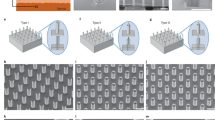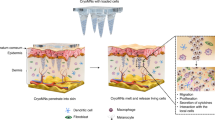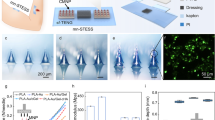Abstract
The easy accessibility of skin makes it an excellent target for gene transfer protocols. To take advantage of skin as a target for gene transfer, it is important to establish an efficient and reproducible delivery system. Electroporation is an established technique for enhancing plasmid delivery to many tissues in vivo. A critical component of this technique is the electrode configuration. Electroporation parameters were optimized for transgene expression with minimal tissue damage with a novel electrode. The highest transgene expression and efficiency of individual cell transformation with minimal damage was produced with eight 150 ms pulses at field strength of 100 V/cm. This electrode design offers the potential for easier and more reproducible electrically mediated cutaneous plasmid delivery than the simple electrodes currently commercially available. This electrode can be a valuable tool in determining the applicability of electrically mediated cutaneous gene transfer.
This is a preview of subscription content, access via your institution
Access options
Subscribe to this journal
Receive 6 print issues and online access
$259.00 per year
only $43.17 per issue
Buy this article
- Purchase on SpringerLink
- Instant access to full article PDF
Prices may be subject to local taxes which are calculated during checkout





Similar content being viewed by others
References
Titomirov AV, Sukharev S, Kistanova E . In vivo electroporation and stable transformation of skin cells of newborn mice by plasmid DNA. Biochim Biophys Acta 1991; 1088: 131–134.
Drabick JJ, Glasspool-Malone J, Somiari S, King A, Malone RW . Cutaneous transfection and immune responses to intradermal nucleic acid vaccination are significantly enhanced by in vivo electroporation. Mol Ther 2000; 3: 249–255.
Glasspool-Malone J, Somiara S, Drabick JJ, Malone RW . Efficient nonviral cutaneous transfection. Mol Ther 2000; 2: 140–146.
Chesnoy S, Huang L . Enhanced cutaneous gene delivery following intradermal injection of naked DNA in a high ionic strength solution. Mol Ther 2001; 5: 57–62.
Maruyama H, Ataka K, Higuchi N, Sakamoto F, Gejyo F, Miyazaki J . Skin-targeted gene transfer using in vivo electroporation. Gene Therapy 2001; 8: 1808–1812.
Dujardin N, Van Deà Smissen P, Préat V . Topical gene transfer into rat skin using electroporation. Pharm Res 2001; 18: 61–66.
Zhang L, Nolan E, Kreitschitz S, Rabussay DP . Enhanced delivery of naked DNA to the skin by non-invasive in vivo electroporation. Biochim Biophys Acta 2002; 1572: 1–9.
Heller R, Schultz J, Lucas ML, Jaroszeski MJ, Heller LC, Gilbert RA et al. Intradermal delivery of interleukin-12 plasmid DNA by in vivo electroporation. DNA Cell Biol 2001; 20: 21–26.
Medi BM, Hoselton S, Marepalli RB, Singh J . Skin targeted DNA vaccine delivery using electroporation in rabbits. I: efficacy. Int J Pharm 2005; 294: 53–63.
Pavselj N, Preat V . DNA electrotransfer into the skin using a combination of one high- and one low-voltage pulse. J Control Release 2005; 106: 407–415.
Babiuk S, Baca-Estrada ME, Foldvari M, Baizer L, Stout R, Storms M et al. Needle-free topical electroporation improves gene expression from plasmids administered in porcine skin. Mol Ther 2003; 8: 992–998.
Gilbert RA, Jaroszeski MG, Heller R . Novel electrode designs for electrochemotherapy. Biochim Biophys Acta 1997; 1334: 9–14.
Sersa G, Cemazar M, Semrov D, Miklavcic D . Changing electrode orientation improves the efficacy of electrochemotherapy of solid tumors in mice. Bioelectrochem Bioenergetics 1996; 39: 61–66.
Faurie C, Phez E, Golzio M, Vossen C, Lesbordes J-C, Delteil C et al. Effect of electric field vectoriality on electrically mediated delivery in mammalian cells. Biochim Biophys Acta 2004; 1665: 92–100.
Gilbert R, Heller R, Jaroszeski MJ . Nonpenetrating electroporation device and method. Patent #6,314,316 B1 2001.
Backman L, Shanbhag VP . Simplex optimization in biochemistry: application of the method in two-phase partition. Anal Biochem 1984; 138: 372–379.
Mir LM, Bureau MF, Gehl J, Rangara R, Rouy D, Caillaud J-M et al. High-efficiency gene transfer into skeletal muscle mediated by electric pulses. Proc Natl Acad Sci USA 1999; 96: 4262–4267.
Lucas M, Heller R . Immunomodulation by electrically enhanced delivery of plasmid DNA encoding IL-12 to murine skeletal muscle. Mol Ther 2001; 3: 47–53.
Heller R . Delivery of plasmid DNA using in vivo electroporation. Preclinica 2003; 1: 198–208.
Andre F, Mir LM . DNA electrotransfer: its principles and an updated review of its therapeutic applications. Gene Therapy 2004; 11 (Suppl 1): S33–S42.
Canatella PJ, Prausnitz MR . Prediction and optimization of gene transfection and drug delivery by electroporation. Gene Therapy 2001; 8: 1464–1469.
Neumann E, Kakorin S, Toensing K . Fundamentals of electroporative delivery of drugs and genes. Bioelectrochem Bioenergetics 1999; 48: 3–16.
Neumann E, Kakorin S, Tsoneva I, Nikolova B, Tomov T . Calcium-mediated DNA adsorption to yeast cells and kinetics of cell transformation by electroporation. Biophys J 1996; 71: 868–877.
Klenchin VA, Sukharev SI, Serov SM, Chernomordik LV, Chizmadzhev YA . Electrically induced DNA uptake by cells is a fast process involving DNA electrophoresis. Biophys J 1991; 60: 804–811.
Sukharev SI, Klenchin VA, Serov SM, Chernomordik LV, Chizmadzhev YA . Electroporation and electrophoretic DNA transfer into cells. The effect of DNA interaction with electropores. Biophys J 1992; 63: 1320–1327.
Bureau MF, Gehl J, Deleuze V, Mir LM, Scherman D . Importance of association between permeabilization and electrophoretic forces for intramuscular DNA electrotransfer. Biochim Biophys Acta 2000; 1474: 353–359.
Satkauskas S, Bureau MF, Puc M, Mahfoudi A, Scherman D, Miklavcic D et al. Mechanisms of in vivo DNA electrotransfer: respective contributions of cell electropermeabilization and DNA electrophoresis. Mol Ther 2002; 5: 133–140.
Satkauskas S, Andre F, Bureau MF, Scherman D, Miklavcic D, Mir LM . Electrophoretic component of electric pulses determines the efficacy of in vivo DNA electrotransfer. Hum Gene Ther 2005; 16: 1194–1201.
Liu F, Heston S, Shollenberger LM, Sun B, Mickle M, Lovell M et al. Mechanism of in vivo DNA transport into cells by electroporation: electrophoresis across the plasma membrane may not be involved. J Gene Med 2006; 8: 353–361.
Heller R, Coppola D, Pottinger C, Gilbert R, Jaroszeski MJ . Effect of electrochemotherapy on muscle and skin. Technol Cancer Res Treat 2002; 1: 385–391.
Dujardin N, Staes E, Kalia Y, Clarys P, Guy R, Preat V . In vivo assessment of skin electroporation using square wave pulses. J Control Release 2002; 79: 219–227.
Brasier AR . Reporter system using firefly luciferase. In: Ausubel FM et al. (eds). Short Protocols in Molecular Biology. John Wiley and Sons: New York, 1992, pp 9-21–9-23.
Acknowledgements
This work was supported by research grants from the National Institute of Diabetes and Digestive and Kidney Diseases (R21 DK55588) and the University of South Florida Center for Molecular Delivery. The pulse generator and electrodes used in this work were supplied by Inovio Biomedical Corporation, San Diego, CA.
Author information
Authors and Affiliations
Corresponding author
Rights and permissions
About this article
Cite this article
Heller, L., Jaroszeski, M., Coppola, D. et al. Optimization of cutaneous electrically mediated plasmid DNA delivery using novel electrode. Gene Ther 14, 275–280 (2007). https://doi.org/10.1038/sj.gt.3302867
Received:
Revised:
Accepted:
Published:
Issue Date:
DOI: https://doi.org/10.1038/sj.gt.3302867
Keywords
This article is cited by
-
Plasma-activated air mediates plasmid DNA delivery in vivo
Molecular Therapy - Methods & Clinical Development (2016)
-
Electrotransfer parameters as a tool for controlled and targeted gene expression in skin
Molecular Therapy - Nucleic Acids (2016)
-
Skin Electroporation of a Plasmid Encoding hCAP-18/LL-37 Host Defense Peptide Promotes Wound Healing
Molecular Therapy (2014)
-
Evaluation of delivery conditions for cutaneous plasmid electrotransfer using a multielectrode array
Gene Therapy (2011)



